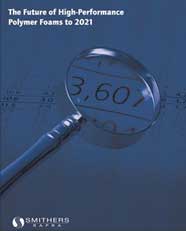Polymer foams market to grow by 3.3% by 2021

The global market for polymer foams is forecast to grow during the 2016–2021 period at a CAGR of 3.3% to US$122.41 billion, driven by changing environmental requirements and demand in construction, according to research house Smithers Rapra.
The new Smithers Rapra report – The Future of High-Performance Polymer Foams to 2021– identifies the size of the market for high-performance polymer foams, and forecasted growth up to 2021. The definition of “high-performance” in this report is based on the specific requirements of the end-use sectors in which they are used, rather than on variations in performance within an individual class of polymer foam. In some industries, a high level of performance is required as standard, while in others, polymer foam types will be used that offer a wide range of low to high-performance, depending on the specific application and/or end user expectations.
Report author Keith Jacques comments: “The polymer foam industry is facing a number of environmental issues on recyclability and waste disposal. Thermoplastic foams can usually be broken down and are easier to recycle, while the heavily crosslinked nature of thermoset foams makes them more difficult to recycle.
“The blowing agents used to produce the foams can cause detrimental environmental effects, although a restriction on the use of CFC (chloro-fluorocarbons) blowing agents has been an important step in making polymer foams more environmentally friendly. New developments in biodegradable foam materials are also starting to address some of the concerns on recyclability and waste disposal.”
As higher demands are placed on different industry segments, requiring higher performance from the materials they use, the polymer foam industry must develop new technologies, or improve on existing ones, to meet these more stringent requirements. One property that is being improved is the reduction in VOCs (volatile organic compounds) to improve workers’ health and the surrounding environment during manufacturing processes, and of TVOCs (total volatile organic compounds), which are volatiles that are emitted during the lifetime of the finished product to improve indoor air quality and reduce health risks to occupants.
The largest end user for polymer foams is in the construction industry, where products are mainly used to provide thermal and acoustic insulation to buildings, and other structures. They are also used in structural earthwork applications to provide lightweight landfill. As governments in all regions continue to focus on energy conservation, and on upgrading the insulation of existing building stock, the demand for insulation foams will continue to grow strongly.
The global demand for high-performance foams in the construction industry is forecast to grow at a CAGR of 10% up to 2021, when demand will be 2.61 million tonnes at a value of US$14.13 billion.
(PRA)Copyright (c) 2017 www.plasticsandrubberasia.com. All rights reserved.












































